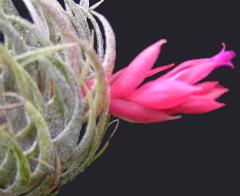
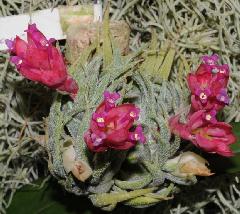
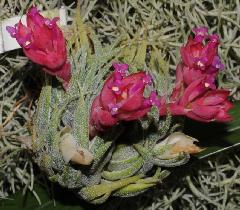

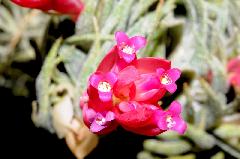
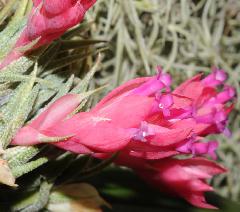
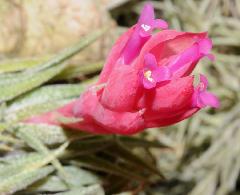
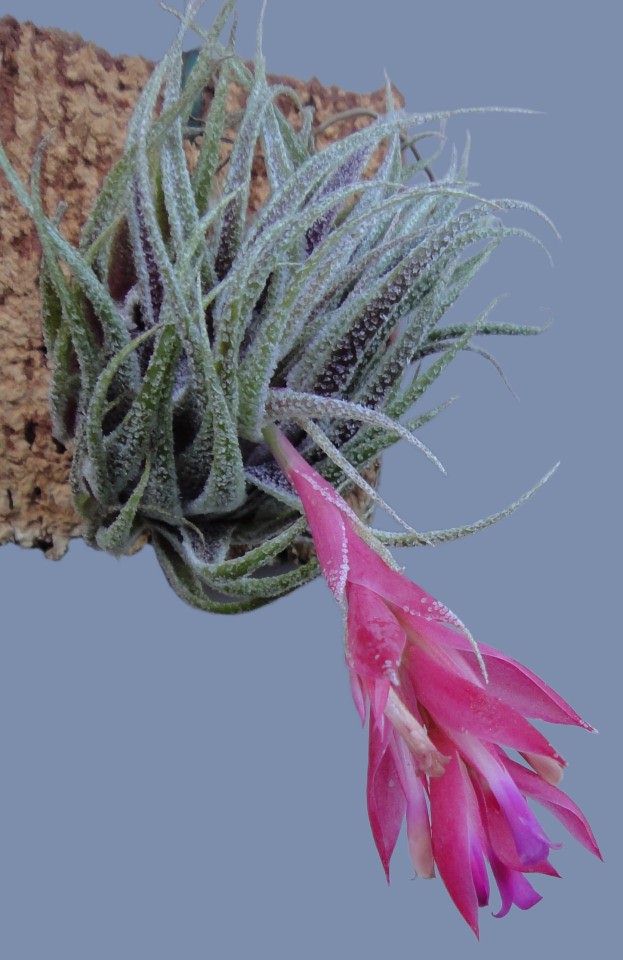
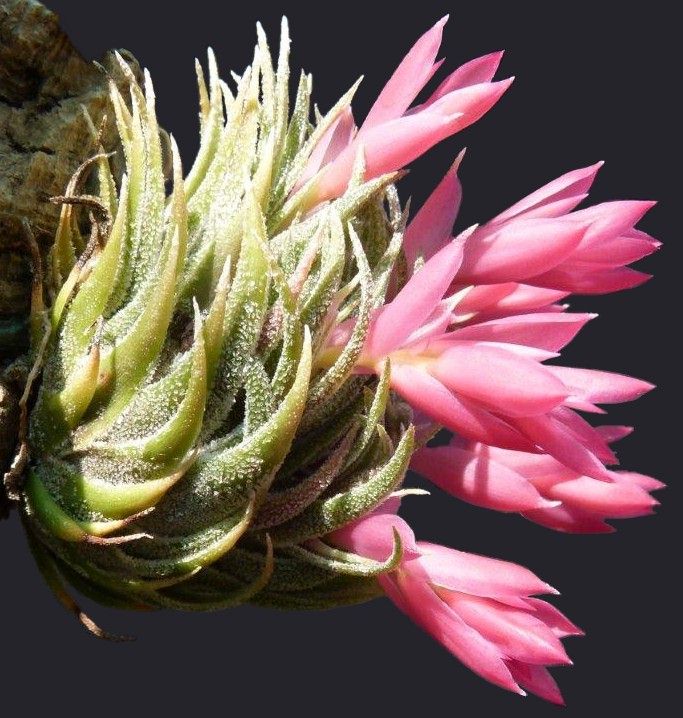
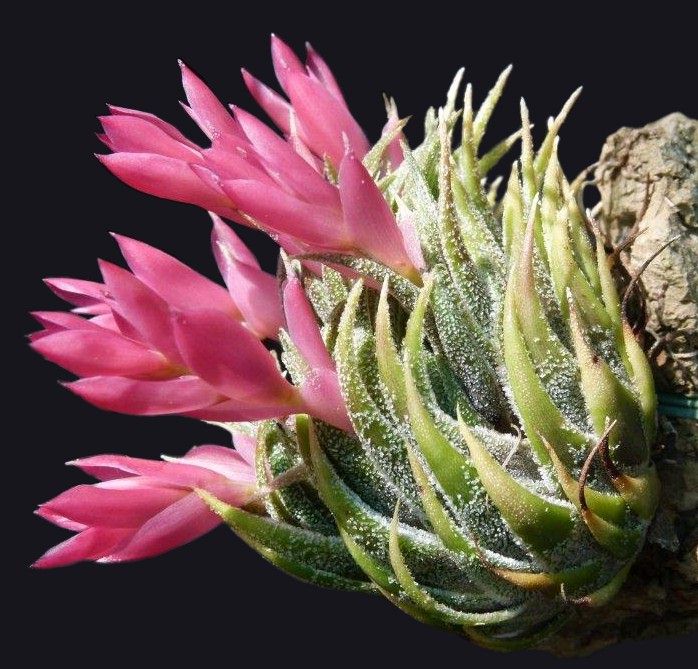
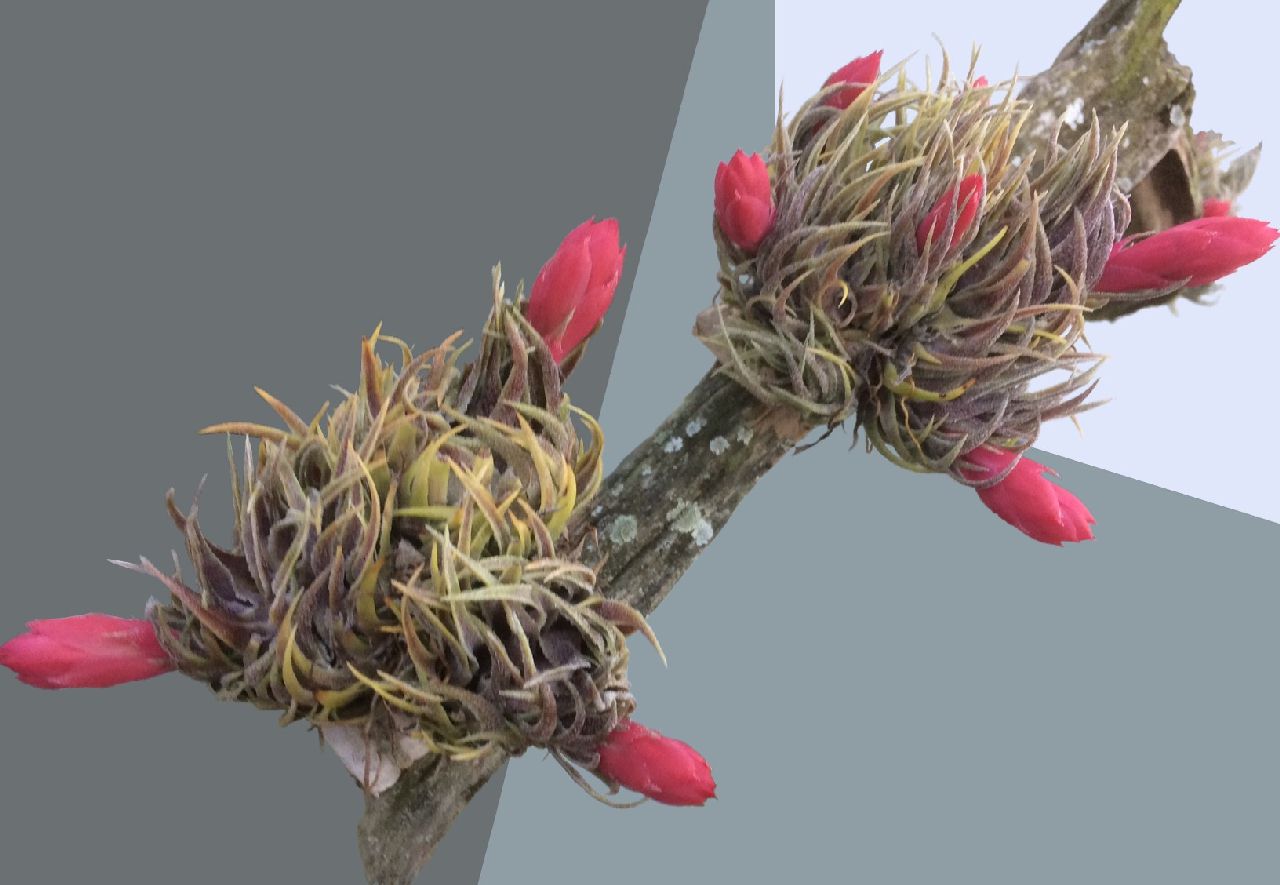
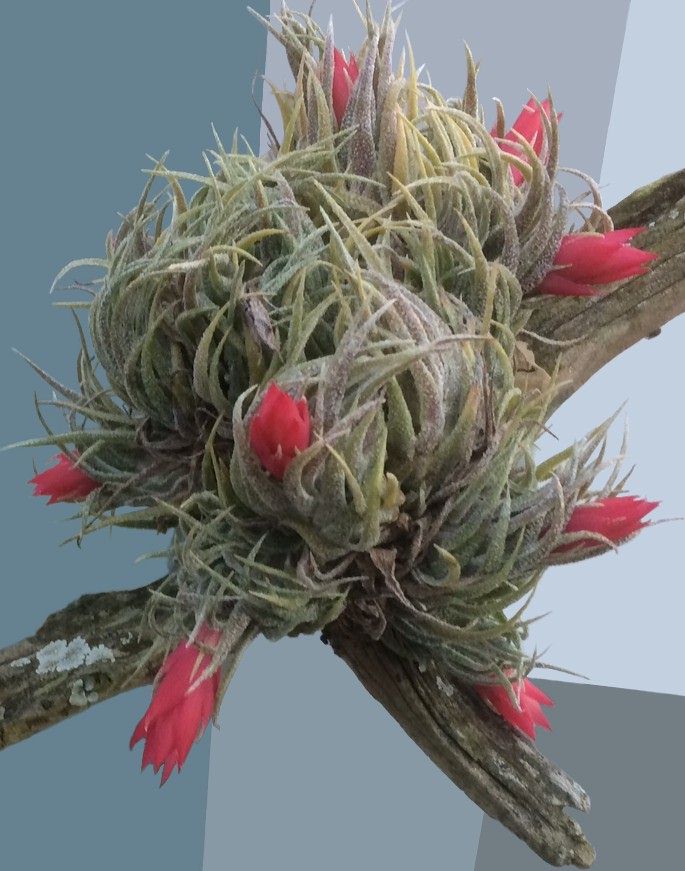

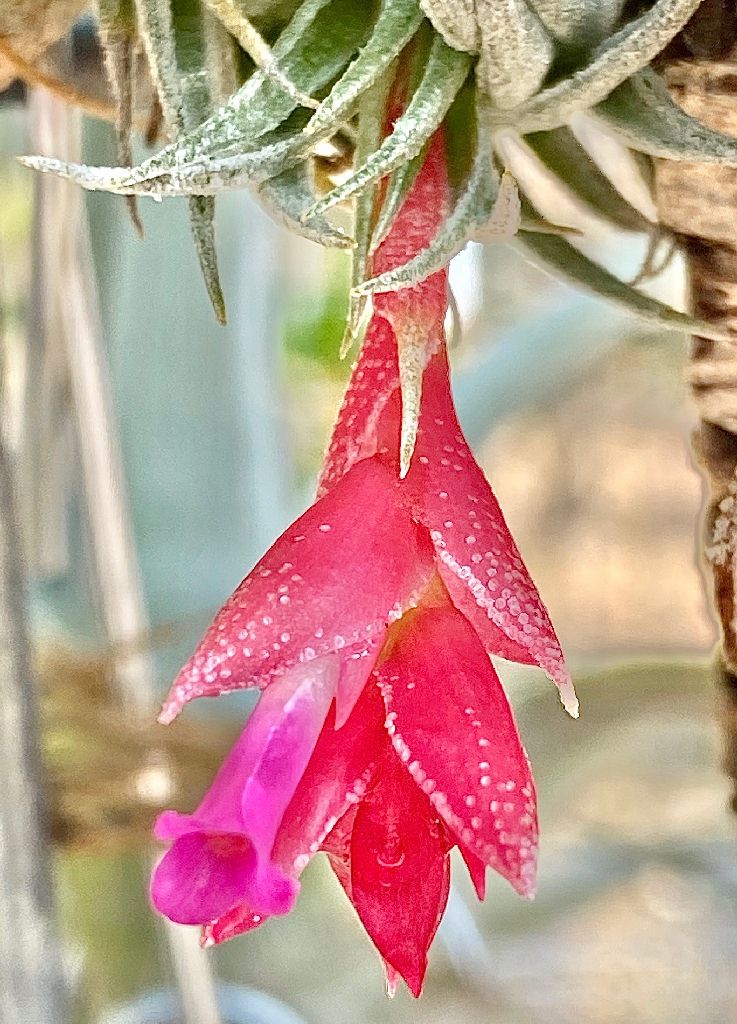
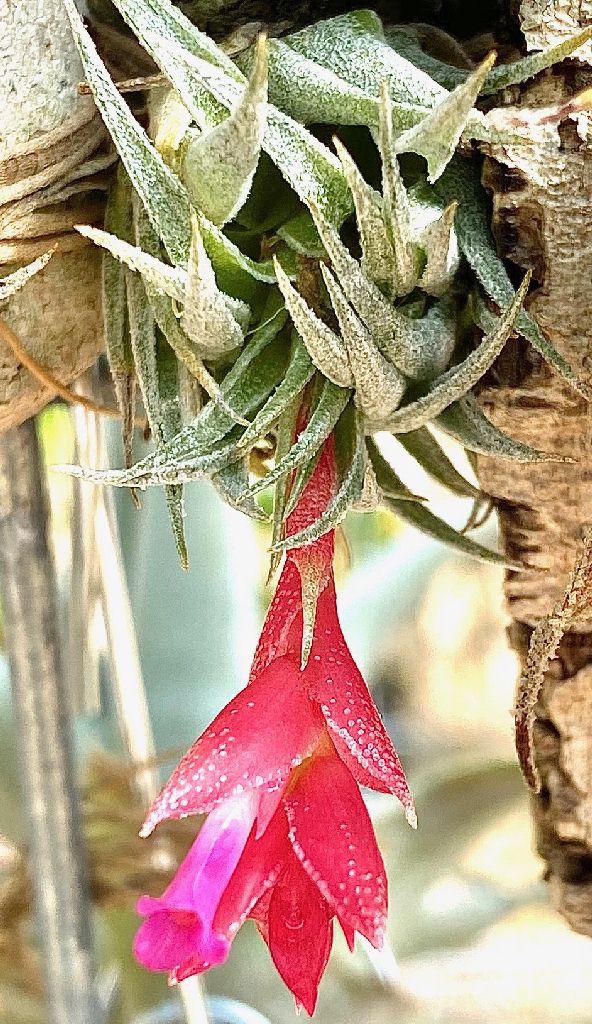
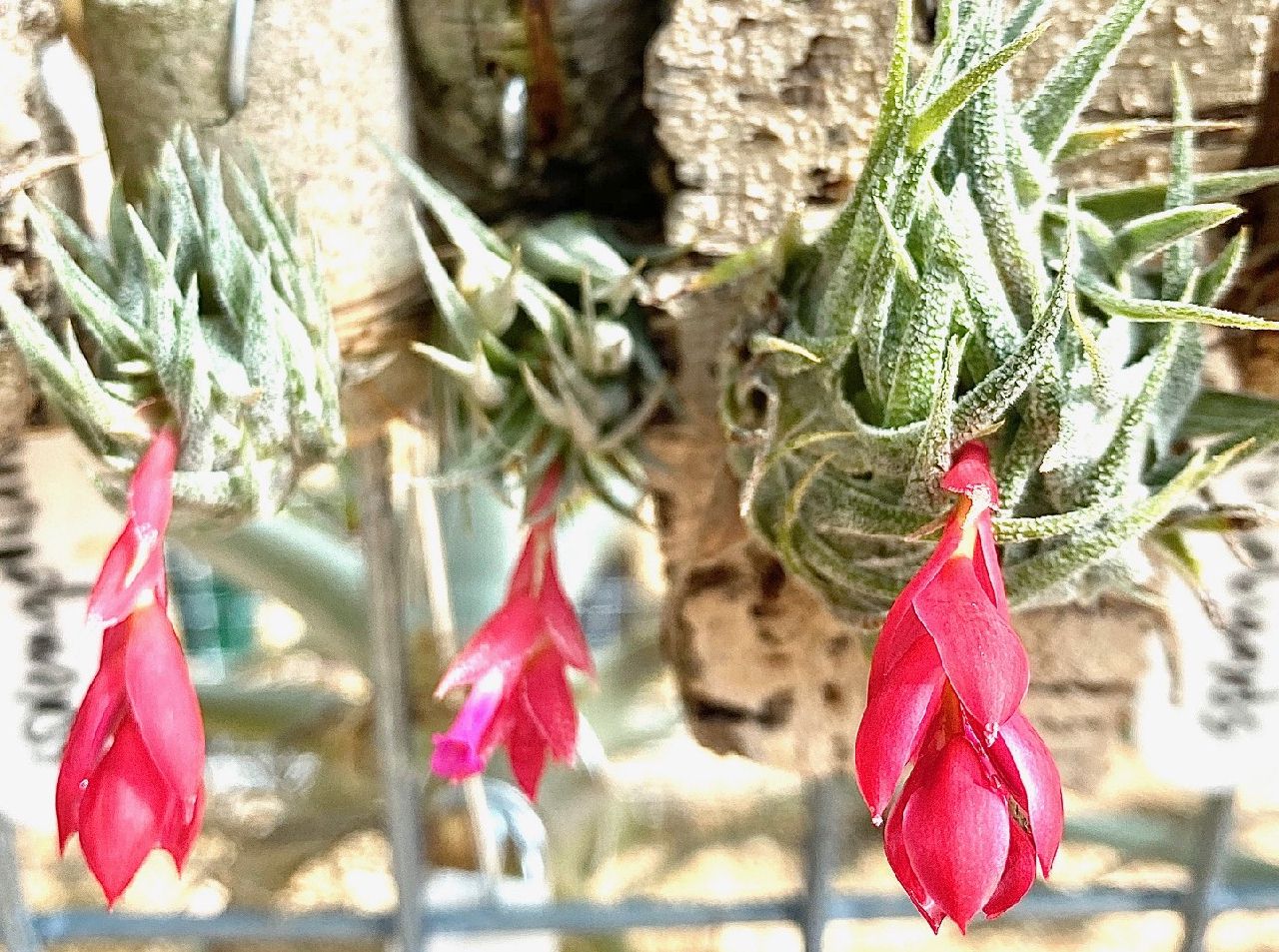
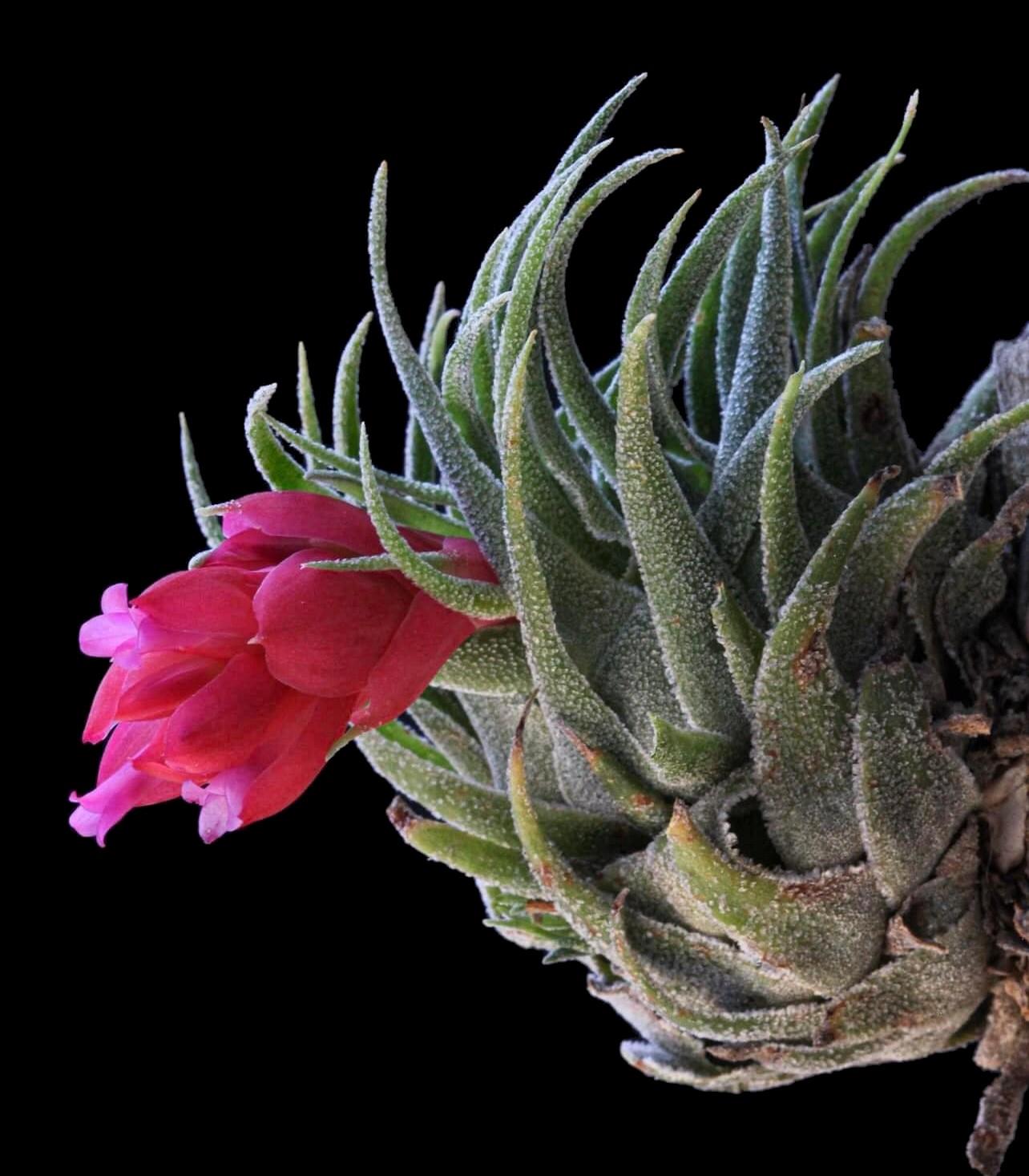
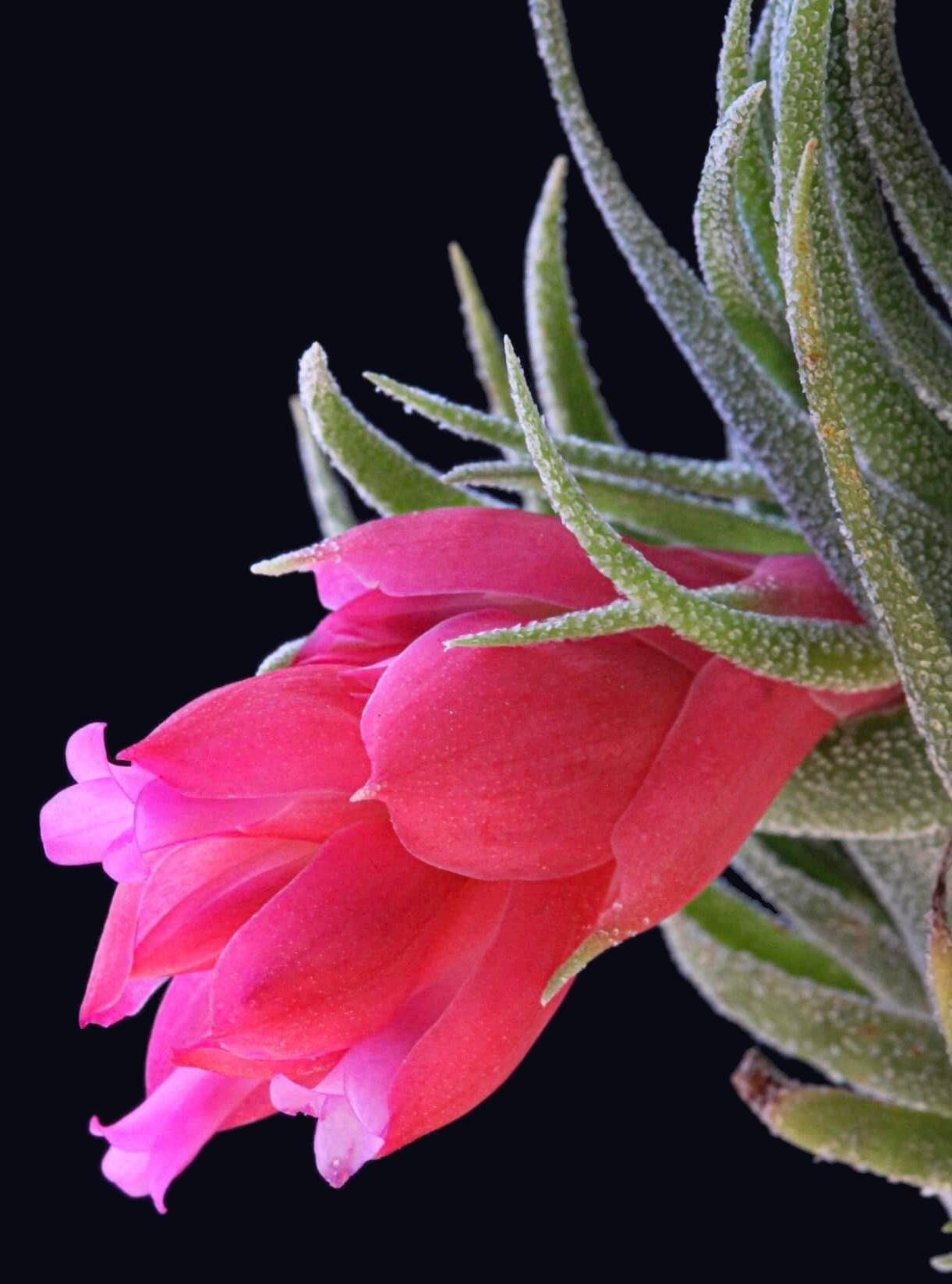
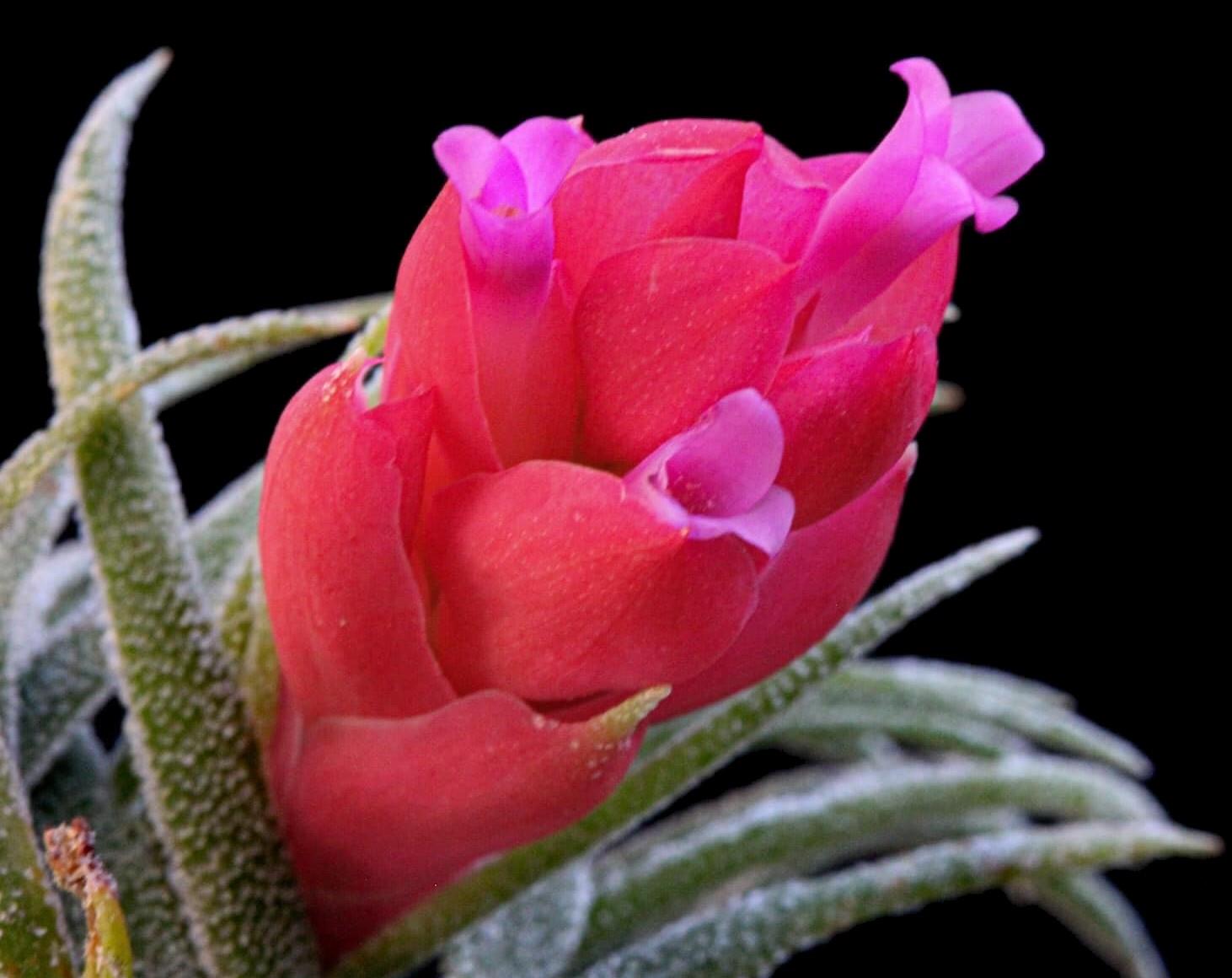
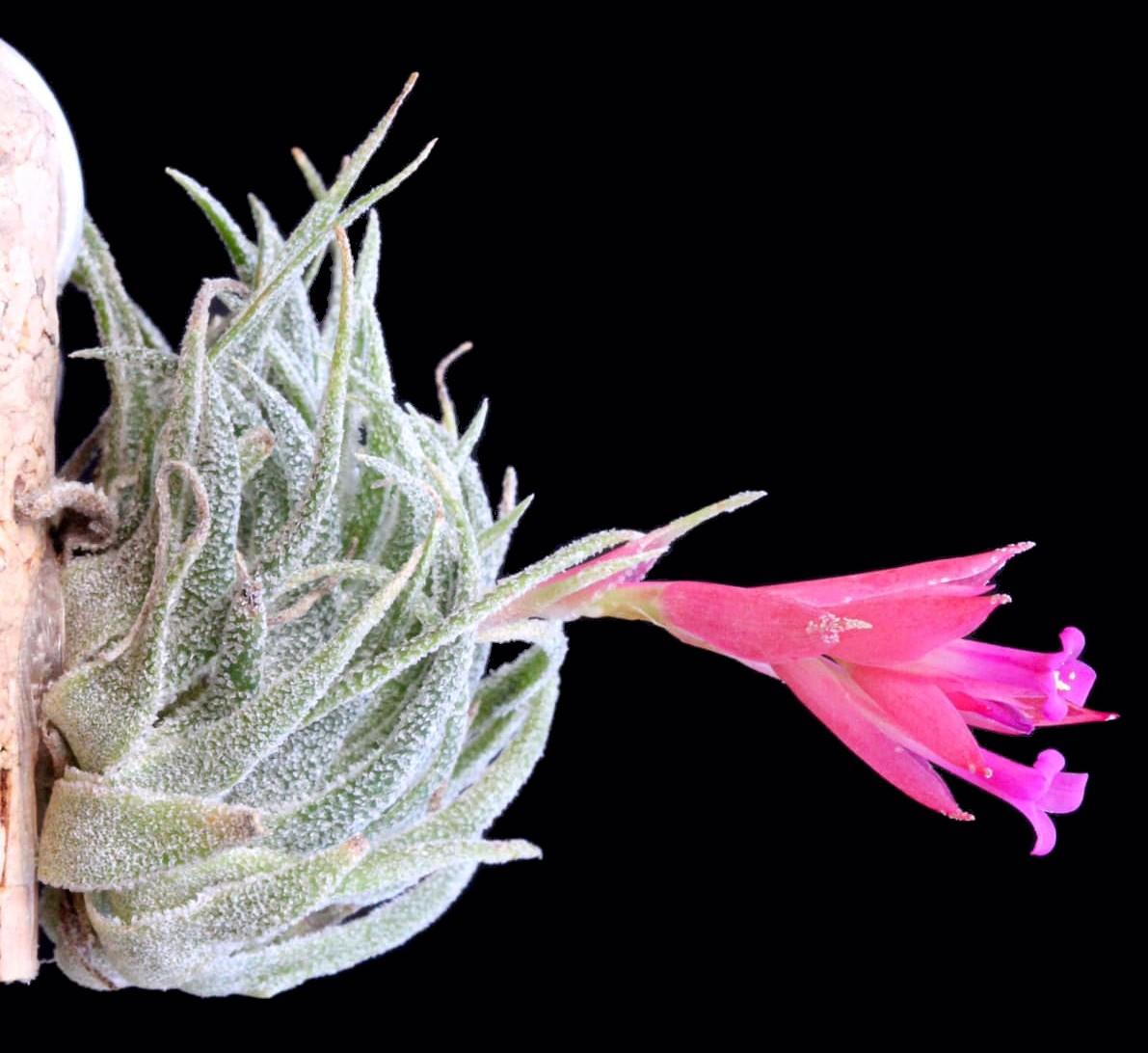
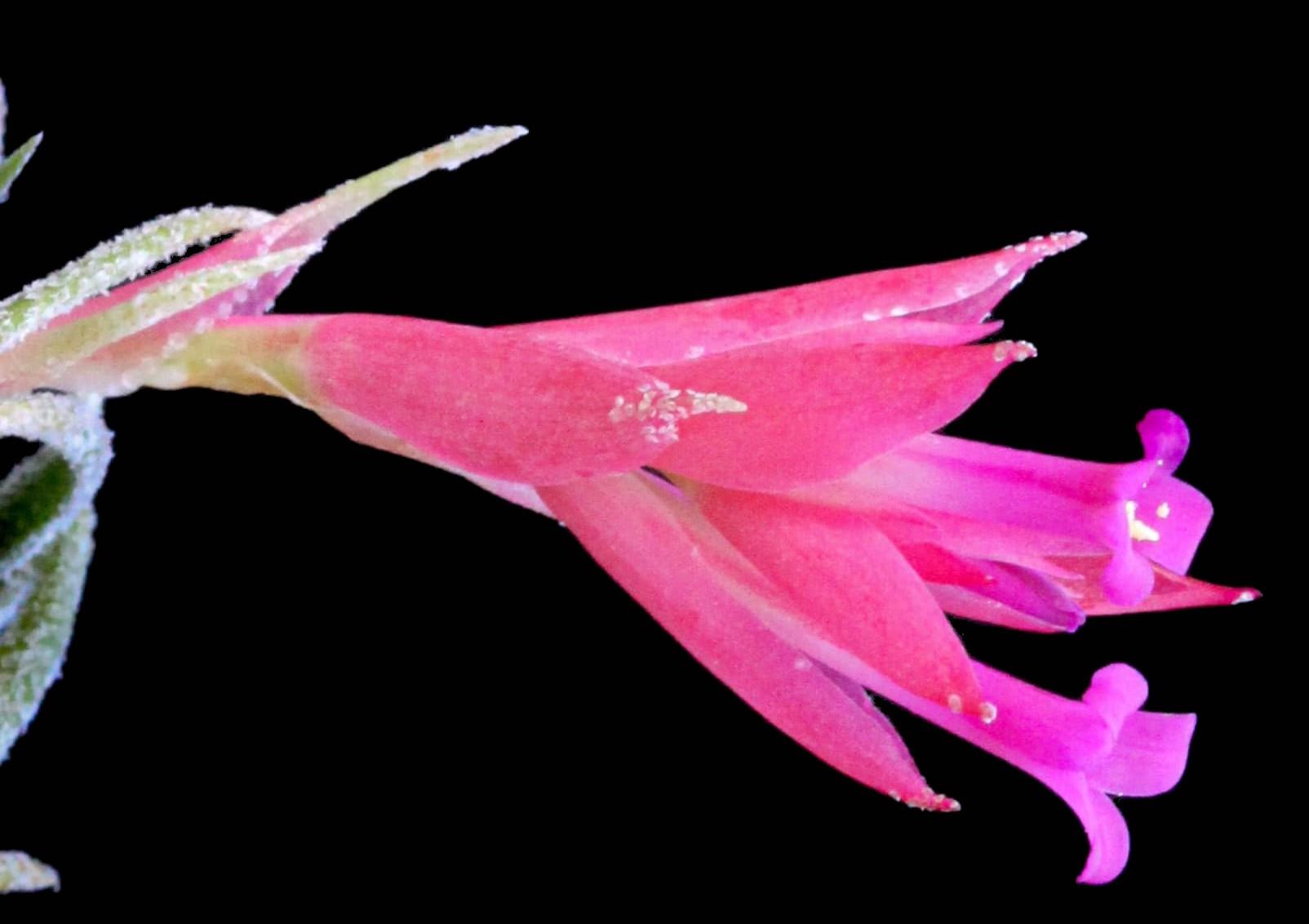
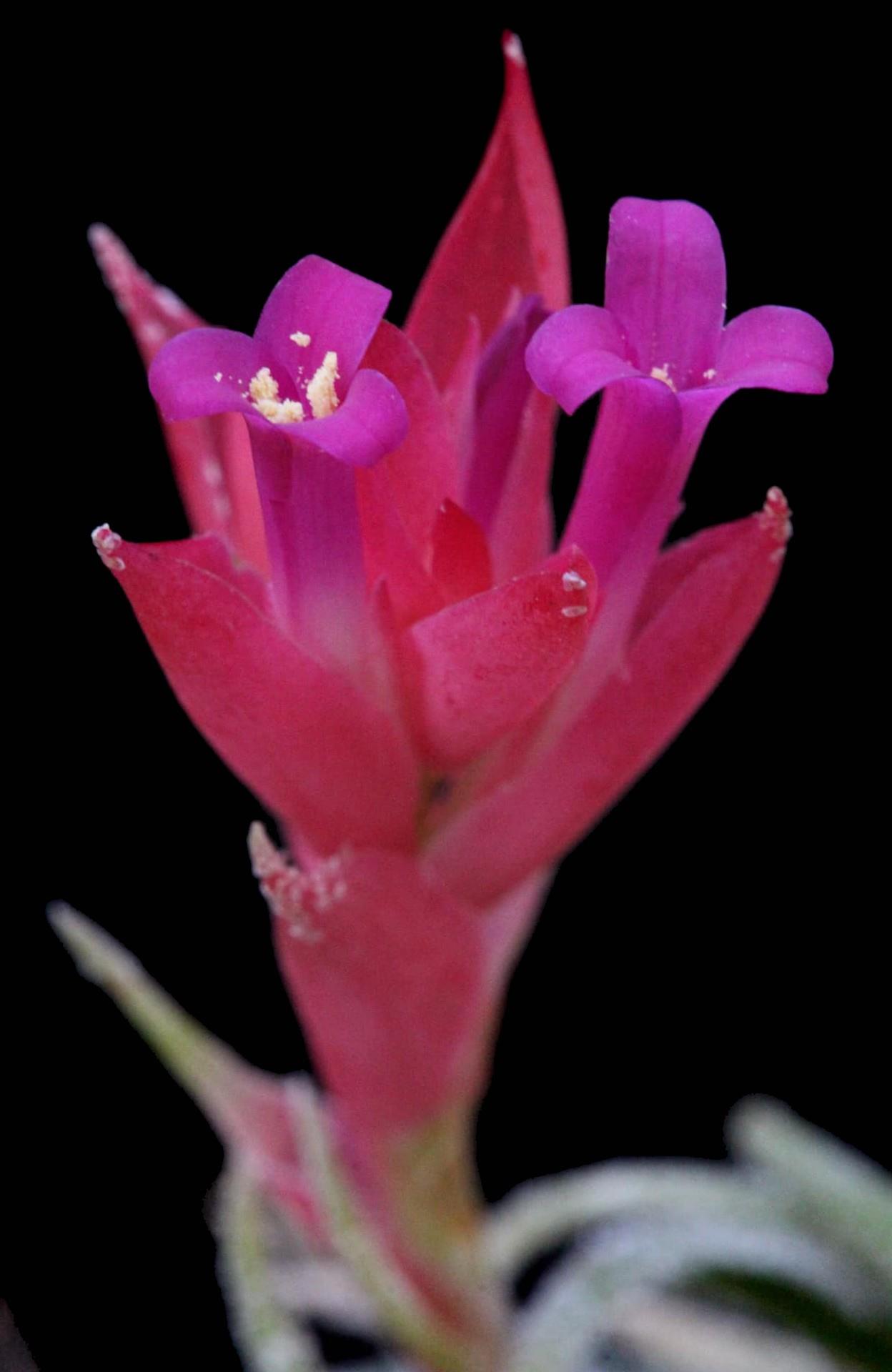
Tillandsia sprengeliana Klotzsch ex Mez in Martius, Fl. Bras. 3(3): 596. 1894.
Tillandsia sprengeliana Klotzsch ex Beer, Bromel. 266. 1857; nomen.
Anoplophytum sprengelianum Beer, Bromel. 266. 1857; nomen.
Tillandsia purpurea sensu Sprengel, Neue Entd. 1: 251.1820: non Ruiz & Pavon, 1802. Tillandsia brachyphylla Baker, Handb. Bromel. 200. 1889; in part, not as to type.
Descr from CITES March 2013 when T. sprengeliana was removed from CITES
Plants with flowers 8.5 -11 cm high, growing alone or in small clusters, epiphytic, mesophytic.
Roots present in adult plants. Rhizome short, 1 to 2.5 cm long, no stems.
Leaves 4.5 to 6.5 cm long, 0.6 cm wide, densely imbricate, base of the leaf 0.8 to 1.2 cm wide, not very distinct, orbicular.
Lamina 3-6 cm long, 0.5 to 0.7 cm wide, narrowly triangular- acuminate, fleshy, slightly caniculate, lepidote, asymmetrical absorbent trichomes, covering the edges of the leaves, grey, giving the plant a greyish-green colour.
Main stem 2.5 to 5.0 cm wide, equivalent to the rosette, thin, straight or slightly curved, glabrous.
Bracts 2 cm long, 0.7 cm wide, elliptical, longitudinally acuminate, pale red in colour, the lower foliage larger than the joints, imbricate, densely lepidote.
Inflorescence 2.5 to 3.5 cm long, 3 cm in diameter, reaching above the rosette of leaves, elliptical or rounded, simple, spiky, with 10 clustered flowers or panicles, with 4-10 branches with 1-3 flowers, with one rudimentary, sterile and erect flower at the upper or slightly spreading part, glabrous spine.
Primary bracts 2 cm long, equal to or longer than the branches, acuminate, oval, inflated, pink in colour, glabrous or lepidote towards the apex.
Floral bracts 1.0 to 1.8cm long, 0.8 to 1.0cm wide, extending beyond the sepals, oval, cuspidate, the lower ones distinctly carinate, membranous, glabrous, red or salmon pink in colour.
Flowers 1.8 to 2.0 cm long, sessile.
Sepals 0.9 to 1.3 cm long, 0.3 cm wide, lanceolate, those in the posterior part slightly concrescent at the base, acuminate, but with a thick central nerve, glabrous, greenish coloured.
Petals 1.5 to 2.0 cm long, 0.25 cm - 0.35 cm wide, elliptical, upright at anthesis, forming a closed corolla, base coloured white, pink or purple towards the apex.
Stamens 1.6 cm long, almost equal to the total size of the petals, included, filaments 1.2 to 1.4cm long, free-ended, flat, not protruding, erect, white, antheras 0.2cm long, 0.03 cm wide, linear, dorsifixed, ochre yellow in colour.
Ovary 0.2 cm long, 1 cm in diameter, style 0.8 cm long, white, stigma 0.1 cm long, trilobate, red in colour.
Desc from Ehlers in Die Bromelie Sonderheft 3 1996 page 42-4
Plant single or growing epiphytically in small groups, stemless, flowering 4 - 9 cm high, 3 - 7 cm in diameter, 20 - 50 leaves forming an erect, mostly secund, subbulbose rosette.
Leaves: up to 9 cm long, polystichous, densely imbricate, clearly secund, soft, grey green, densely pruinose lepidote, appearing grey green furry.
Sheaths 8 - 12 mm wide, elliptic - triangular, little distinct.
Blade 3 - 6 cm long, 5- 7 mm wide above the sheath, narrow triangular acuminate, erect - secund, almost flat or slightly channelled, both sides densely covered with large (0.5 - 0.8 mm in diameter), round, irregular trichomes.
Scape: 2.5 to 5 cm long, equaling the rosette, slender, almost erect to recurved, glabrous, covered by imbricate elliptic, long attenuate, densely lepidote scape bracts.
Inflorescence: exceeding the rosette, up to 5 cm long, up to 3 cm in diameter, elliptic or subglobose, densely polystichous, simple or bipinnate at the base with 4 - 10 erect or slightly spreading branches.
Primary bracts: up to 2 cm long, oval, acuminate, inflated, as long or longer than the spikes, thin, pink, glabrous or the tip small fine lepidote.
Spike lax 2 -3 flowered (including a sterile apical rudimentary flower), with a thin stem. Flower almost sessile, 18- 20 mm long.
Floral bracts: 10 -18 mm long, exceeding the sepals, 8 -12 mm wide, oval, acute, the upper ones not carinate, the lower ones more or less distinctly carinate, membranaceous, nerved, pink or salmon, glabrous.
Sepals: 9 - 13 mm long, 3 mm wide, lanceo¬late acuminate, not carinate, however with a thick midnerve, free, glabrous, light green or pink.
Petals: 1.5 - 2 cm long, 2.5 - 3.5 mm wide, oblanceolate, the rounded tips spreading, upper part lilac - pink, the base white.
Stamens: enclosed. Filament 1.2 - 1.4 cm long, thin, ribbonlike, straight, white. Anther 2 mm long, 0.3 mm wide, linear, fixed at base, brownish yellow. Style 1 cm long, white, upper third red. Stigma small, red.
Type. Collector unknown and without data (holotype B, B photo), undoubtedly from Brazil.
DISTRIBUTION. ( according to Smith & Downs) Epiphytic, near sea level, eastern Brazil.
BRAZIL. ESPIRITO SANTO: Rio Jucu, Vitoria, 26 Jul 1939, Foster 503 (GH). RIO DE JANEIRO: Ilha do Cabo Frio, Arraial do Cabo, 8 Aug 1953, Segadas-Vianna et al no. Restinga-I-7 12 (R, US); without exact locality, Saint-Hilaire B 106 (P). WITHOUT EXACT LOCALITY: Freyreis s n (S).
Habitat:( according to Ehlers) East Brazil, State of Rio de Janeiro and Espirito Santo. Sea level to 300 m. Material studied: T. sprengeliana leg. C. de Araujo, Busius, received 1978 s. n; EB 81445 K. & R. Ehlers, Arraial do Cabo in bushes at sea level; EB 81448, Ilha do Cabo Frio.
Comments: K. & R. Ehlers were not able to find this plant in 1981 and 1986 on a trip to Rio Jucu, Vitoria, a location in Espirito Santo cited by L. B. Smith.
Compared to the description there are in habitat as well as in cultivation examples with bipinnate inflorescence with 4 flowered side spikes.
Article in J. Brom. Soc. 45(2):65-8. 1995
A Guide to the Species of Tillandsia Regulated by Appendix II of CITES, Part III Harry E. Luther of Mulford B. Foster Bromeliad Identification Center, The Marie Selby Botanical Gardens, 811 South Palm Avenue, Sarasota, FL 34236, U.S.A.
Part III of the Guide concludes the series begun in the November-December 1994 issue of the JOURNAL. It includes Tillandsia sprengeliana, T. sucrei and T. xerographica. The drawings were made by Barbara Culbertson, the photographs by Vern Sawyer and Pamela Koide.
Tillandsia sprengeliana Klotzsch ex Mez in Martius, Flora brasiliensis 3(3): 596. 1894.
DISTRIBUTION. Endemic to restinga and Atlantic Forest at low elevations in the states of Rio de Janeiro and Espirito Santo, Brazil.
STATUS IN HORTICULTURE. Rare in cultivation.
DESCRIPTION. Plant an epiphyte, nearly stemless, 4-8 cm tall, single or densely clustering;
roots wiry, 1 mm or less in diameter, brown.
Leaves densely arranged, curving secund erect, 25 to 50 in number, grey-green to silver-grey, only a few of the oldest leaves reflexing toward the root system or stembase.
Leaf sheaths broadly elliptic, 6-10 mm wide, subdensely and coarsely white lepidote except at the base.
Leaf blades narrowly triangular, acute to acuminate, 3-8 cm long, 4-8 mm wide, slightly channeled, soft, subdensely and irregularly covered with coarse, spreading white trichomes and appearing conspicuously rough or pruinose.
Scape erect, as long as or exceeding the leaves.
Scape bracts like the leaves but less lepidote and tinged reddish.
Inflorescence 10-25 mm long, simple, densely polystichously 4- to 10-flowered.
Floral bracts ovate, acute to apiculate, 15-18 mm long, soft, sparsely white lepidote, rose-red.
Flowers opening during the day and lasting 2-3 days.
Sepals lanceolate, acute, 9-12 mm long, free, sparsely lepidote to glabrous, pale green.
Corolla spreading.
Petals narrowly oblanceolate, 15-20 mm long, rose.
SUMMARY. Small (4-8 cm tall) plant with curving, secund erect, slightly channeled leaves that appear grey-green or silver-grey and conspicuously rough or pruinose due to the less than complete and irregular covering of coarse spreading trichomes; a short rose-red inflorescence with rose, spreading petals.
VEGETATIVELY RESEMBLES: Tillandsia kautskyi E. Pereira which has a more pseudobulbous form with more erect leaves that are densely covered with appressed trichomes and appear metallic; ( Note Butcher grows both T. sprengeliana and T. kautskyi and they are very similar indeed. I follow Renate Ehlers (pers comm.) who says the leaves of T. sprengeliana are velvety to the touch!
T. brachyphylla Baker which has broader leaves that are densely covered with coarse spreading trichomes and more conspicuously channeled;
T. thiekenii R. Ehlers which has more channeled to involute succulent leaves that, due to its pendent, lithophytic habit, are more tightly erect and not at all secund.
From S&D 1977
171. Tillandsia sprengeliana Klotzsch ex Mez in Martius, Fl. Bras. 3(3): 596. 1894.
Tillandsia sprengeliana Klotzsch ex Beer, Bromel. 266. 1857; nomen.
Anoplophytum sprengelianum Beer, Bromel. 266. 1857; nomen.
Tillandsia purpurea sensu Sprengel, Neue Entd. l: 251. 1820; non Ruiz & Pavon, 1802.
Tillandsia brachyphylla Baker, Handb. Bromel. 200. 1889; in part, not as to type.
Plant stemless, flowering 6-9 cm high.
Leaves many in a dense rosette, more or less secund-twisted, 3-4 cm long, covered with coarse spreading cinereous scales;
Sheaths broadly elliptic, merging with the blades; blades very narrowly triangular, acuminate, 5 mm wide at base, involute-subulate.
Scape erect, to 4 cm long, glabrous;
scape-bracts imbricate and covering the scape, broadly ovate with a linear blade, membranaceous.
Inflorescence to 3 cm long, 4-8-flowered, densely polystichous-flowered, subglobose, glabrous.
Floral bracts imbricate, broadly ovate, rounded and apiculate, to 17 mm long, exceeding the sepals, membranaceous, red;
flowers subsessile.
Sepals equally subfree, lanceolate, acuminate, 11 mm long;
petals to 19 mm long, rose (?);
stamens included.
Type. Collector unknown and without data (holotype B, B photo), undoubtedly from Brazil.
Distribution. Epiphytic, near sea level, eastern Brazil.
BRAZIL. Espirito Santo: Rio Jucu, Vitoria, 26 Jul 1939, Foster 503 (GH). Rio de Janeiro: Ilha do Cabo Frio, Arraial do Cabo, 8 Aug 1953, Segadas-Vianna et al no. Restinga-I-712 (R; US); without exact locality, Saint-Hilaire B 106 (P). Without exact locality: Freyreis s n (S).
From Baker 1889
184. T. BRACHYPHYLLA. Baker in Journ. Bot, 1888, 16.
T. Sprengeliana Klotzsch.
Anoplophytum Sprengelianum, Beer, A. Binoti E. Morren (M.D.).
Acaulescent. Leaves densely rosulate, lanceolate, acute, not acuminate, 1½ -2 in. long, ¼ - 1/3 in. broad above the dilated base, tapering gradually from the base to the point, moderately firm in texture, densely lepidote all over. Peduncle 2-3 in. long; bract-leaves small, lanccolate. Inflorcscence a lax simple spike an inch long; flowcr-bracts ovate or oblong, acute, red, scariose, ½ - ¾ in. long. Sepals oblong, acute, l/3 – ½ in. long. Petals half as long again as the calyx.
Hab. Rio Janeiro, Sello, St. Hilaire 106! Glaziov 8018! Introduced alive by Binot in 1879.
From Mez 1935
299. T. Sprengeliana Klotzsch ap. Beer, Bromel. (1857) 266. –
Anoplophytum Sprengelianum Beer, l. c.
Tillandsia purpurea Spreng. (non Ruiz et Pav.) Neue Entdeck. I. (1820) 251.
T. brachyphylla Bak. Bromel. (1889) 200, non alibi, e. p. –
Acaulis; foliis plerumque unilateraliter curvatis unciformibus, rigidulis, 30-40 mm longis, persensim acutis, tomento lepidum maximarum pruinose obtectis. Scapus ad 40 mm longus, vaginis e late ovato optime acuminatis membranaceis, internodia superantibus indutus. Inflorescentia 4-8-flora, simplicissima, quaquaverse florigera, ad 30 mm longa et 25 mm diam. metiens, subglobosa; bracteis amplis, late ovalibus, apice mucrone imposito rotundatis, glabris, membranaceis, ad 17 mm longis, sepala bene superantibus, Flores 20 mm longi, erecti, rosei; sepalis aequaliter basi minute connatis, glabris, lanceolatis, longe acutis et mucronulatis, 11 mm longis. Petala ad 19 mm longa. stamina e fauce corollae emergentia, stylum superantia.
Brasilien: staat Rio de Janeiro, bei Cabo Frio (Ule), ohne standortsangabe (St. Hilaire Cat. B² n. 106).
Key to Brazilian Tillandsias, with red or pink petals from Die Bromelie, Sonderheft 3 1996
1. Stamens - exceeding the flower tube => paraensis
- included in the flower tube => 2
2. Leaf blade - filiform and grasslike => globosa
- triangular => 3
3. Plant - 4 - 8 cm in diameter => 8
- 10 - 25 cm in diameter, forming a more or less spreading rosette, stemless => 4
4. Floral bracts - lepidote => 5
- glabrous or nearly so: Plant 6 - 15 cm diameter, inflorescence elliptic or globose, spikes elliptic, sublax with 1 - 3 (- 5) flowers, floral bracts carinate, glabrous or punctulate lepidote, sepals glabrous => roseiflora
5. Inflorescence - elliptic or subglobose => 6
- elongate => 7
6. Leaves - soft, green or reddish, appressed lepidote, spike lax, 2 - 4 flowered, floral bracts shorter than sepals, petals red - violet => geminiflora
- soft, grey, densely lepidote with spreading trichomes, spikes dense, 3 - 12 flowered, floral bracts densely lepidote, exceeding the lepidote sepals => gardneri
7. Leaves - subsucculent, stiff, inflorescence with 4 - 6 spikes => chapeuensis
- Plant only 11 - 13 cm in diameter, an open silvery star-shaped rosette, leaves appressed lepidote, inflorescence with 5 - 7 spikes => grazielae
8. Plant - short - caulescent => 9
- stemless, forming an erect, often subbulbose rosette, leaves often somewhat secund, inflorescence elliptic or subglobose, flowers red or violet, filament not plicate => 10
9. Plant - 3 to 5 cm in diameter, pine cone shaped, dorsiventral, pendant, leaves green, silvery appressed lepidote, inflorescence simple, distichous => reclinata
- 4 to 8 cm in diameter, an erect-secund rosette, the basal leaves recurved, leaves cinereous-lepidote, inflorescence compound, spikes lax, floral bracts carinate, shorter than the lepidote sepals, the posterior ones carinate and 4 mm connate => sucrei
10. Floral bracts - glabrous or nearly so => 14
- lepidote => 11
11. Inflorescence - simple => 12
- bipinnate: Leaves channelled, regularly lepidote with coarse cinereous scales, inflorescence with up to 8 spikes which are laxly 3 - 4 flowered, the posterior sepals carinate, 1/3 to 1/2 connate, lithophytic growing at sea level => brachyphylla
12. Inflorescence - with polystichous flowers => 13
- with distichous flowers: Plant ca. 4 cm in diameter, short caulescent, small pine cone shaped, pendant, leaves grey appressed lepidote => reclinata
13. Leaves - secund, thin and soft, grey with appressed trichomes, looking like grey velvet, scape densely lepidote, inflorescence simple, sometimes compound of up to 3-flowered spikes, floral bracts carmine-red, sepals slightly lepidote, free, posterior ones carinate, petals violet-rose => heubergeri
- Leaves not secund, subsucculent, green, covered with coarse grey scales, plant pendant, floral bracts rose, sepals more lepidote, petals pink => thiekenii
14. Posterior sepals - not carinate => 15
- carinate => 16
15. Leaves many, green-grey, densely lepidote with irregular cumulated coarse trichomes, appearing rough pruinose, epiphytic at sea level => sprengeliana
- Leaves many, narrow triangular, with appressed trichomes, appearing metallic, epiphytic 700 - 1000 m => kautskyi
16. Plant - 2.5 to 5 cm in diameter, rosette of broadly triangular leaves with shorter blade, very densely and regularly silvery subpruinose lepidote, appearing like silvery velvet, sepals carinate and short connate, lithophytic 1800 - 2200 m => organensis
- Plant bigger, up to 15 cm in diameter, rosette often bulbose, leaves grey - green appressed grey lepidote, appearing like grey velvet, bipinnate with 1 - 3 (-5 ) flowered spikes, floral bracts conspicuously carinate, posterior sepals carinate, epiphytic => roseiflora